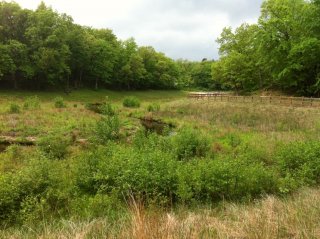Addressing Water Quality Challenges Using a Watershed Approach
On this Page:

Overview
We all live in a watershed — the area that drains to a common waterway, such as a stream, lake, estuary, wetland, aquifer or even the ocean — and our individual actions can directly affect it.
- Watersheds supply drinking water, provide recreation and sustain life.
- More than $450 billion in food and fiber, manufactured goods and tourism depends on clean water and healthy watersheds.
Working together to address today's water resource challenges using a watershed approach is the most effective framework to protect our nation's water resources.
A watershed approach to address today's water resource challenges --
- Is hydrologically defined
- geographically focused
- includes all stressors (air and water)
- Involves all stakeholders
- includes public (federal, state, local) and private sector
- is community-based
- includes a coordinating framework
- Strategically addresses priority water resource goals (e.g. water quality, habitat)
- integrates multiple programs (regulatory and voluntary)
- is based on sound science
- is aided by strategic watershed plans
- uses adaptive management
Below you will find links to a number of EPA and external resources for organizations involved in watershed protection and restoration. Resources that pertain to specific aspects of using the watershed approach are available using the tabs on this page.
EPA Resources
The Healthy Watersheds Program is a systemic approach that protects aquatic biota and their habitat as well as watershed characteristics and processes that support them such as vegetative riparian corridors and headwaters, hydrology, geomorphology and natural disturbance regimes. The holistic protection approach provided by the Healthy Watersheds Program is essential for addressing the pervasive threats to healthy watersheds, including loss and fragmentation of habitat, hydrologic alteration, invasive species and climate change.
- Advancing Watershed Protection Through Land Conservation: Eligibilities & Approaches in the Clean Water Act Section 319 Program (pdf) This fact sheet provides background information, resources, and 'Getting Started Tips' for CWA Section 319 Program staff who aim to incorporate land protection strategies in their Program activities. For more information, visit the Healthy Watersheds Program page on land conservation.
Lake and Reservoir Restoration Manual (PDF): This guidance manual is written for the informed citizen who is interested in lakes and reservoirs. The manual includes information to help users identify, describe, and define their lake problems and evaluate available lake and watershed management practices for addressing problems or protecting current quality. It describes the process of developing a site-specific lake or reservoir management plan and illustrates how to put a lake management plan in practice and evaluate its effectiveness.
National Estuaries Program (NEP): NEP is a network of voluntary community-based programs that safeguards the health of important coastal ecosystems across the country.
Watershed Academy: The Watershed Academy is a focal point at EPA for providing training and information on implementing watershed approaches. The Academy's self-paced training modules and webcast seminars provide current information from national experts across a broad range of watershed topics.
Total Maximum Daily Load(TMDL): A TMDL is a pollution budget -- it establishes the maximum amount of a pollutant allowed in a waterbody and serves as the starting point or planning tool for restoring water quality.
External Resources
The following links exit the site
Conservation Technology Information Center (CTIC)'s Know Your Watershed: An initiative coordinated by the CTIC, a non-profit data and technology information transfer center, to encourage the formation of local, voluntary watershed partnerships and help assure that these partnerships successfully attain their goals.
- Environmental Assessment Resources;
- Visioning, Consensus Building, and Planning Resources;
- Implementation Resources (Technical Assistance, Guidance, Case Studies);
- Funding Resources (Grants and Financing Assistance; Public Outreach Resources; and
- Comprehensive Resource Guides.
National Association of Conservation Districts: This site provides links to almost 3000 conservation districts around the country. NACD also provides publications, educational materials, and conferences and workshops.
Urban Land Institute: The mission of the Urban Land Institute is to provide responsible leadership in the use of land in order to enhance the total environment. They address issues such as smart growth, transportation, housing, and finance. They also provide educational documents, conferences, and a continueing education program.
Strategic Habitat Conservation Handbook (PDF): The U.S. Fish and Wildlife Service developed this handbook to guide planners who are developing habitat conservation plans under the Endangered Species Act.
